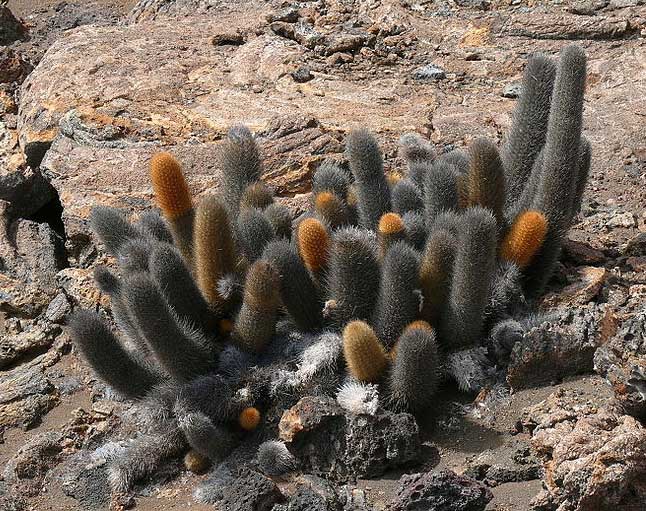Brachycereus nesioticus (*) Cladus: Eukaryota The lava cactus (Brachycereus nesioticus) is a species of cactus and the sole species of the genus Brachycereus. The plant is a colonizer of lava fields, hence its common name.
The plant has soft furry spines and grows in clumps to a height of about two feet (60 cm). New growth is yellow, turning to brown, which darkens to gray with age. The creamy white flowers are visible in the early morning hours only, and normally fade by 8 in the morning. Habitat As its name suggests, the lava cactus occurs exclusively on barren lava fields, lying at sea level. Not only is it one of the few plants that survive in this extremely dry, challenging habitat, it is often one of the first plants to colonise a fresh lava flow. Biology Despite the scientific interest that the Galápagos Islands have received ever since Darwin visited in 1835, and the numerous observations of the lava cactus, the biology of this plant remains poorly known. Like all cacti, this succulent plant is capable of storing moisture in its stems when water is available, enabling it to survive periods of drought, and the spines, which are actually the leaves of the cactus, provide defense against any plant-eating animals. The lava cactus flowers very briefly, with its cream-coloured blooms opening just before dawn, and usually shrivelling by seven or eight o’clock in the morning. Threats While the Galápagos are a protected area, and are considered one of the most unspoiled areas remaining on the planet, the fauna and flora of these islands still face major threats, such as introduced species, pressure from increasing tourist numbers, and a decline in the maintenance of protective laws. However, the lava cactus is not currently known to be facing any specific threats, and is considered to be Vulnerable based primarily on its restricted distribution. Conservation The unique biodiversity of the Galápagos has been recognized and these islands are well protected as a result, being classified as a National Park and a Natural World Heritage Site. More specifically for the lava cactus, the government of Ecuador prohibits the collection of any plant in the Galápagos. References * Tye (2000). Brachycereus nesioticus. 2006. IUCN Red List of Threatened Species. IUCN 2006. www.iucnredlist.org. Retrieved on 11 May 2006. Listed as Vulnerable (VU D2 v2.3) Source: Wikispecies: All text is available under the terms of the GNU Free Documentation License |
|

